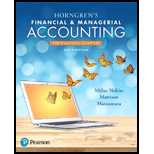
Concept explainers
(1)
Accounts receivable
Accounts receivable refers to the amounts to be received within a short period from customers upon the sale of goods and services on account. In other words, accounts receivable are amounts customers owe to the business. Accounts receivable is an asset of a business.
Bad debt expense is an expense account. The amounts of loss incurred from extending credit to the customers are recorded as bad debt expense. In other words, the estimated uncollectible accounts receivable are known as bad debt expense.
Direct write-off method:
This method does not make allowance or estimation for uncollectible accounts, instead this method directly write-off the actual uncollectible accounts by debiting bad debt expense and by crediting accounts receivable. Under this method, accounts would be written off only when the receivables from a customer remain uncollectible.
To journalize: The write-off of $1,100 of accounts receivable as uncollectible, under direct write-off method.
(2)
Person V’s balance in accounts receivable at May 31, 2018.
Want to see the full answer?
Check out a sample textbook solution
Chapter 8 Solutions
Horngren's Financial & Managerial Accounting, The Financial Chapters (6th Edition)
- Please solve this General accounting questions step by steparrow_forwardPlease provide the correct answer to this general accounting problem using accurate calculations.arrow_forwardThe Keller Company reported total manufacturing costs of $237,000; manufacturing overhead totaling $52,000 and direct materials totaling $75,000. How much is direct labor cost? helparrow_forward
- Helparrow_forwardIn pension accounting, actuarial gains and losses are____. (a) Added to pension obligation directly (b) Always recognized immediately in profit or loss (c) Recognized in other comprehensive income (d) Deferred indefinitelyarrow_forwardVista Market Store's daily register records an opening float of $250. During the day, the store made $3,120 in cash sales and $4,500 in credit card sales, while processing $180 in returns. Based on these transactions, calculate the expected cash amount in the register at the end of the day. Helparrow_forward

 AccountingAccountingISBN:9781337272094Author:WARREN, Carl S., Reeve, James M., Duchac, Jonathan E.Publisher:Cengage Learning,
AccountingAccountingISBN:9781337272094Author:WARREN, Carl S., Reeve, James M., Duchac, Jonathan E.Publisher:Cengage Learning, Accounting Information SystemsAccountingISBN:9781337619202Author:Hall, James A.Publisher:Cengage Learning,
Accounting Information SystemsAccountingISBN:9781337619202Author:Hall, James A.Publisher:Cengage Learning, Horngren's Cost Accounting: A Managerial Emphasis...AccountingISBN:9780134475585Author:Srikant M. Datar, Madhav V. RajanPublisher:PEARSON
Horngren's Cost Accounting: A Managerial Emphasis...AccountingISBN:9780134475585Author:Srikant M. Datar, Madhav V. RajanPublisher:PEARSON Intermediate AccountingAccountingISBN:9781259722660Author:J. David Spiceland, Mark W. Nelson, Wayne M ThomasPublisher:McGraw-Hill Education
Intermediate AccountingAccountingISBN:9781259722660Author:J. David Spiceland, Mark W. Nelson, Wayne M ThomasPublisher:McGraw-Hill Education Financial and Managerial AccountingAccountingISBN:9781259726705Author:John J Wild, Ken W. Shaw, Barbara Chiappetta Fundamental Accounting PrinciplesPublisher:McGraw-Hill Education
Financial and Managerial AccountingAccountingISBN:9781259726705Author:John J Wild, Ken W. Shaw, Barbara Chiappetta Fundamental Accounting PrinciplesPublisher:McGraw-Hill Education





